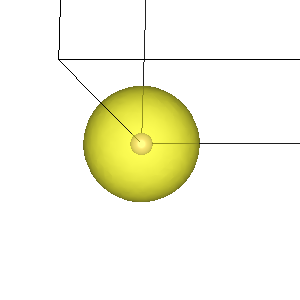
This tutorial covers the basics for spin-polarized and open-shell calculations in JDFTx, using the most basic system of all, a hydrogen atom. Additionally, it introduces the eigenvalue output and the exact-exchange options in the code.
First, lets set up a hydrogen atom calculation exactly as we would based on the previous tutorials. Save the following to Hatom.in:
lattice Cubic 15 ion H 0 0 0 1 coulomb-interaction Isolated coulomb-truncation-embed 0 0 0 ion-species GBRV/$ID_pbe.uspp elec-cutoff 20 100 dump End None
and run jdftx -i Hatom.in. Since there is only one atom, we don't need geometry optimization. Notice that the final energy Etot = -0.45851 Hartrees, which is rather different from the analytical exact energy -0.5 Hartree (= -1 Rydberg = -13.6 eV).
The reason for this disrepancy is that, by default, this DFT calculation is spin-unpolarized, that is it assumes an equal number of up and down spin electrons. This assumption is correct for the water molecule with a closed shell of 8 valence electrons that we dealt with so far, but is incorrect for the hydrogen atom which has only one electron. This electron must be either an up or down spin, so that the magnetization (Nup - Ndn) is +1 or -1. We can invoke a spin-polarized calculation and specify the magnetization using the commands:
spintype z-spin #z-spin = up/dn polarization (non-relativistic spin) elec-initial-magnetization +1 yes #yes = hold magnetization fixed, no = optimize it
Add these commands to Hatom.in and rerun jdftx. Now we find Etot = -0.4994 Hartrees, in much better agreement with the analytical result. Check that using magnetization -1 produces exactly the same result.
Next, let's examine the Kohn-Sham eigenvalue of the Hydrogen orbitals. Add the following commands to Hatom.in to output the eigenvalues:
dump End BandEigs dump-name Hatom.$VAR
and rerun jdftx. It will now output a binary file Hatom.eigenvals, whose contents you can examine using one of the distributed scripts:
binaryToText Hatom.eigenvals
Note that the Kohn-Sham eigenvalues for the occupied (spin up) orbital is approximately -0.28 Hartrees, in very poor agreement with the exact analytical result of -0.5 Hartrees. (The unoccupied state eigenvalue does not converge in this variational minimize calculation since it absolutely does not contribute to the total energy. Converging empty state eigenvalues reliably requires a band-structure calculation, or the use of the converge-empty-states command.)
This eigenvalue inaccuracy is a well-known limitation of semi-local DFT approximations such as the default PBE generalized-gradient approximation used here. In these functionals, the electrons effectively interact with themselves (self-interaction error) which makes the Kohn-Sham eigenvalues of occupied states too high, and leads to the well-known underestimation of band gaps of solids. Note however that the total energies are still almost surprisingly accurate.
For the one-electron hydrogen atom, we can eliminate this self-interaction error using Hartree-Fock, which evaluates the exact exchange energy directly from the wavefunctions, instead of approximating it from the density (and omits the correlation density functional). We can specify Hartree-Fock theory using the command:
elec-ex-corr Hartree-Fock
Running jdftx on Hatom.in with this command added, will at first however fail because exact-exchange based calculations are only supported for norm-conserving pseudopotentials, whereas the GBRV pseudopotentials used above are ultrasoft pseudopotentials. Therefore, additionally replace the ion-species line and the elec-cutoff line above with
ion-species SG15/$ID_ONCV_PBE.upf elec-cutoff 30
to use the norm-conserving SG15 pseudopotential set, which requires a higher plane-wave cutoff. Now run jdftx again (it will take around ten times as long) and examine the eigenvalues using binaryToText. Now we find that the eigenvalue of the occupied state is -0.4998 Hartrees, exactly equal to the total energy Etot = -0.4998 Hartrees, both in very good agreement with the analytical result of -0.5 Hartrees.
The Hartree-Fock calculations are exact for the hydrogen atom, but are much less accurate than semi-local DFTs for most molecules and solids, especially for calculating total energies and geometries. A common practice to empirically get the best of both worlds is to mix a fraction of exact exchange into a semi-local DFT calculation. For example, to use the popular PBE0 or HSE06 functionals in JDFTx, you would specify the hyb-PBE0 or hyb-HSE06 options to elec-ex-corr. In this special case however, we find that the eigenvalues for those (-0.336 and -0.329 respectively) are closer to the semi-local DFT result, than to the exact Hartree-Fock result.